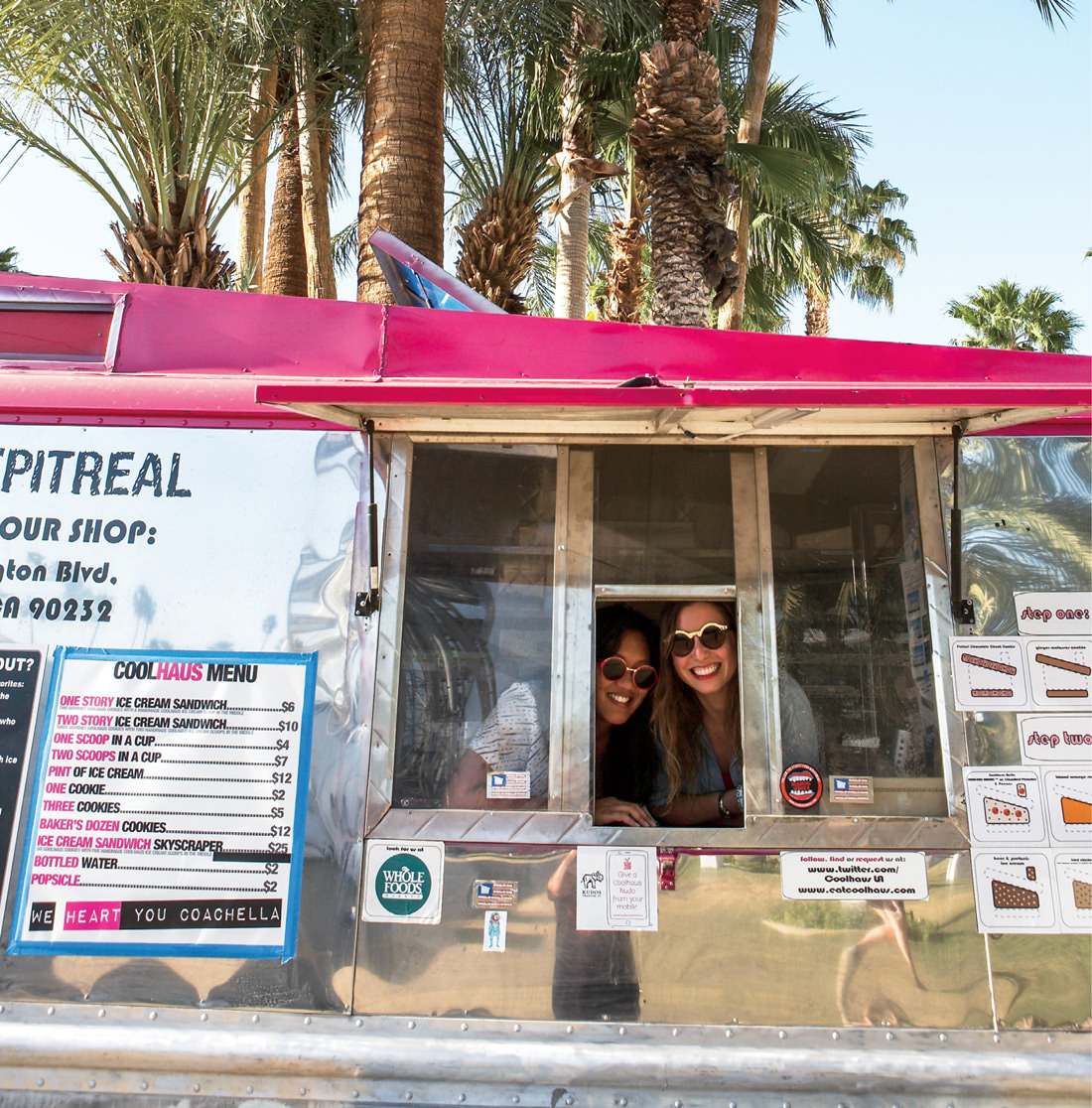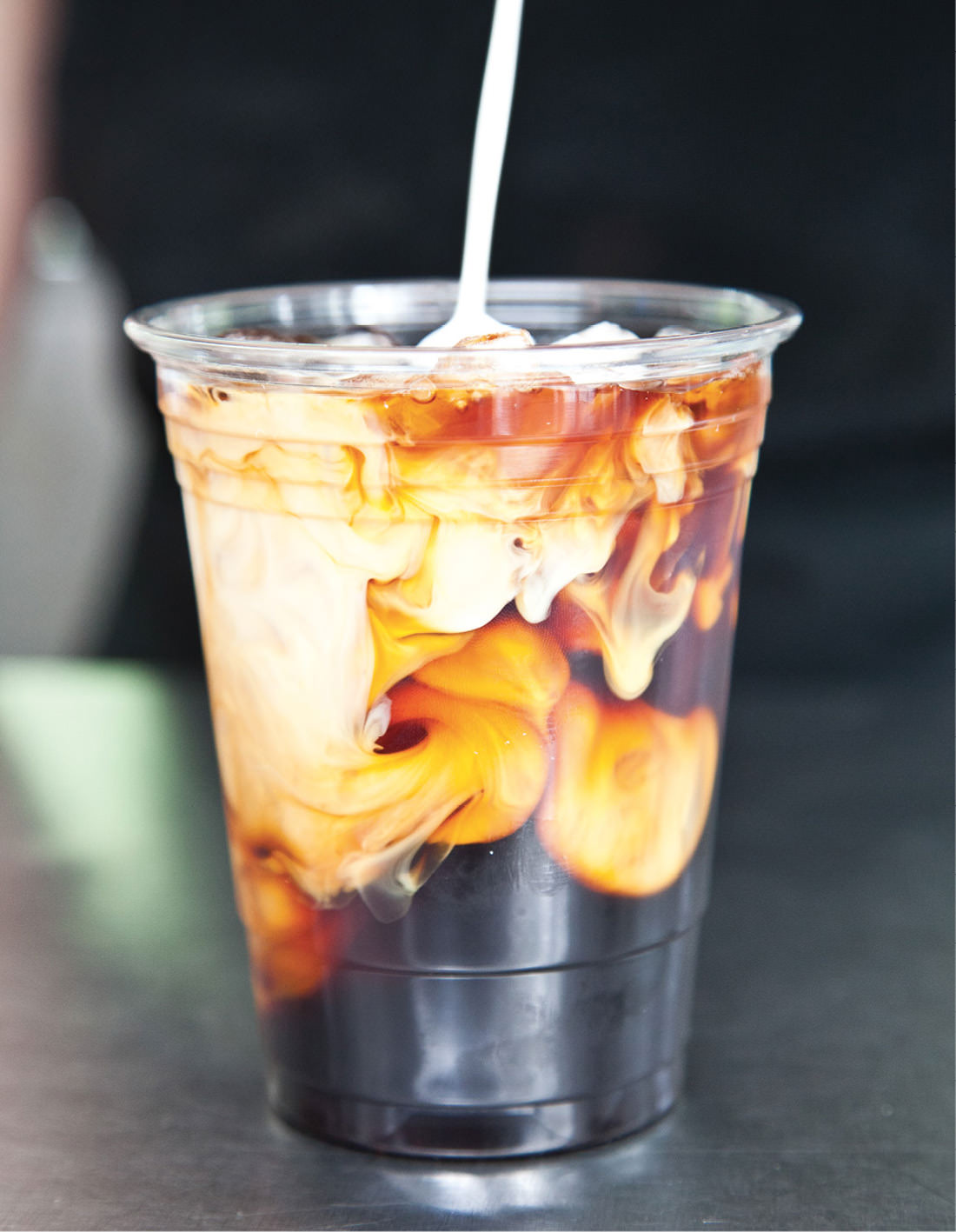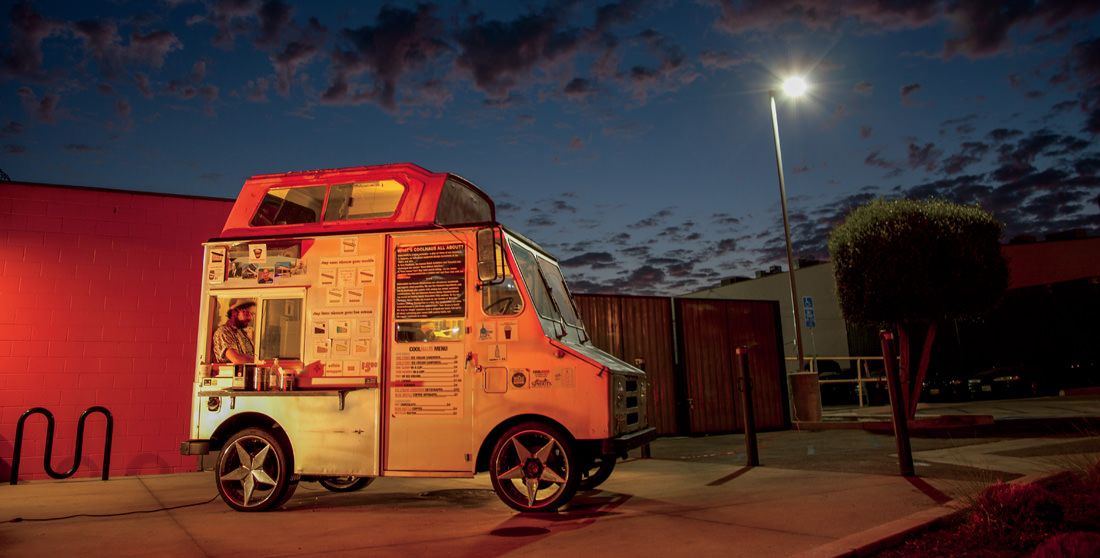Sweet Rebellion
All the cool kids in school had junk food. They always had a good stash of sweets, like Gummi Bears or Nerds. We had hopelessly dull health food or eccentric ethnic food. Our homes were not super-popular for playdates with kids looking for good after-school snacks.
So we’re not going to start this cookbook off by waxing nostalgic on how our families inspired our culinary journeys. There won’t be tales of a pint-size Natasha licking the spoon just out of Mom’s mixing bowl. Or recollections from Freya of comforting oven aromas pervading her northeast L.A. home. In fact, Coolhaus may have been a backlash to our nonculinary upbringings, which were (probably wisely) spent outside of the kitchen.
Today, when we bring flavors like Fried Chicken & Waffle into our parents’ homes, they wonder, Where did this all come from? Yet they proudly make space in their freezers for packs of Mint-imalism sandwiches—refreshing Dirty Mint Chip Ice Cream wedged between two fudgy Double Chocolate Cookies—or pints of our salty, sweet, rich, and velvety Brown Butter Candied Bacon. To us, that feels just as good as the days when they would tack our A+ homework on the refrigerator door.
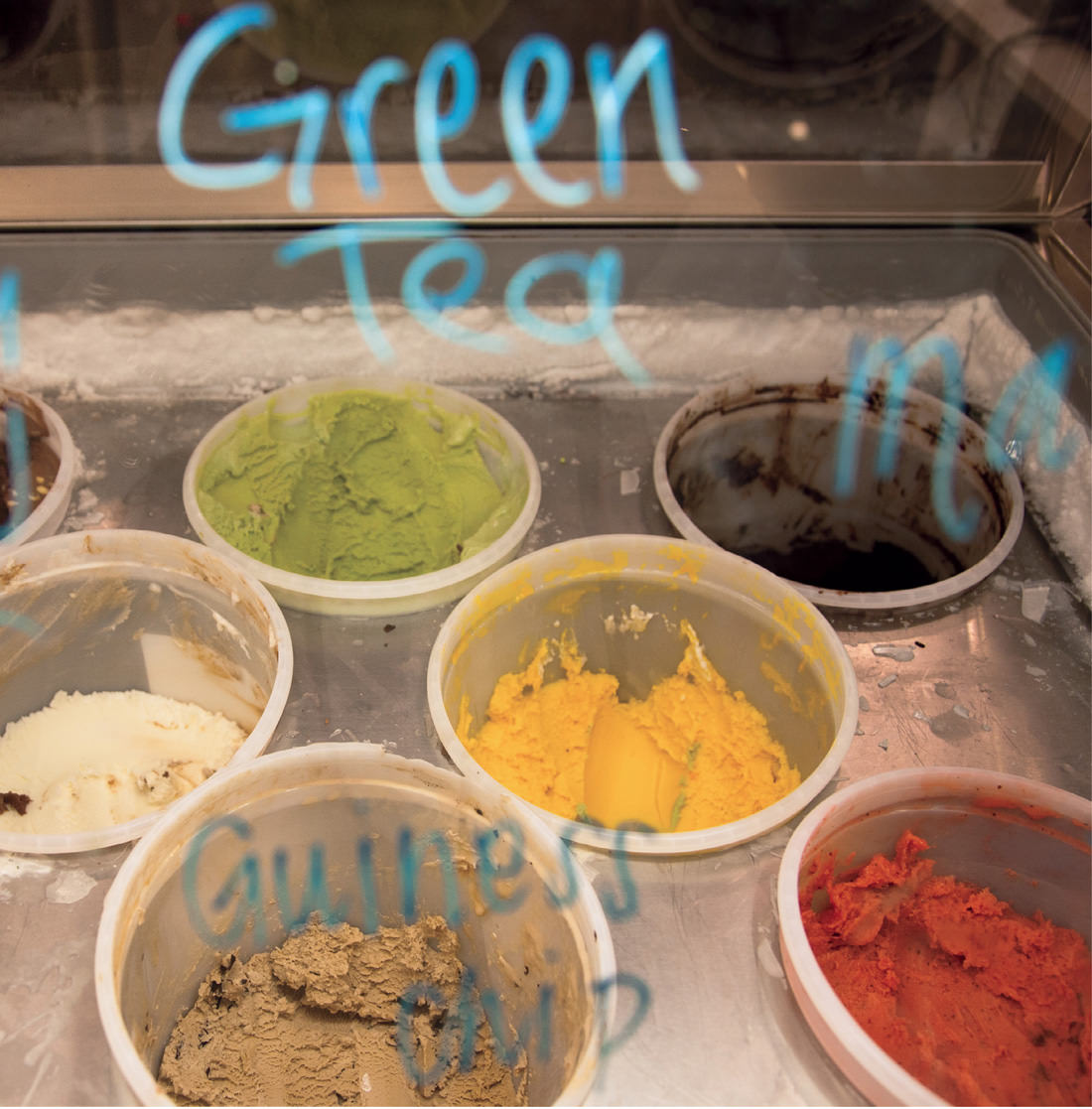
Meet Natasha (right)
To Natasha’s architect dad, French cooking meant making coq au vin and drinking the extra wine while stirring the pot. Her mom, a cartoon animator, was a Berkeley-bred vegetarian. Health food ruled. Lunch was a brown paper bag with a banana on the bottom, a fruit cup, and a natural–peanut butter sandwich (no jelly allowed) or tuna with no mayo and frighteningly dark green lettuce. Definitely not tradable commodities in the school lunchroom.
Natasha’s experience making desserts as a child extended to opening a box of brownie mix, stirring in oil and eggs, placing it in the oven . . . and forgetting all about it as she trotted off to soccer practice. (Her parents came home to a smoke-filled kitchen.)
Desserts in her household were low-fat ice creams and uncool birthday carrot cakes. She is still grateful for a trip to the East Coast to visit relatives, during which she was introduced to her first full-fat ice cream—a life-changing experience.
In college, Natasha’s close friend Justine taught her that decadent desserts weren’t just bought in elegant pastry shops; they could actually be whipped up at home. Justine thought nothing of making an iced three-layer cake to reward her boyfriend for doing well on a math exam. From then on, butterfat found a permanent place in Natasha’s consciousness.
Today, not a day goes by when she’s not surrounded by incredible flavors like Salted Chocolate or Froot Loops and Milk.
Meet Freya (left)
Freya’s childhood meals were a mishmash of her Filipino and Chinese heritage. She could always count on rice being in the rice cooker. While Freya embraced the cuisine of her heritage, she sometimes wanted fried chicken or pizza. Instead, pig’s-blood and offal stew, called dinuguan, or boiled duck fetus, known as balut, were often on the dinner table. Desserts were gelatinous affairs like halo halo, a mix of ice cream, shaved ice, red beans, coconut gelatin cubes, and a plethora of assorted artificial ingredients, and puto, a wiggly rice cake that doesn’t taste like much of anything. Or her dad’s inventions, things like mashed-up avocado with milk, sugar, and creamed corn.
Freya remembers her first salty chocolate chip cookie as a turning point, making her think, Why can’t every dessert be like this? In a new quest of mixing the savory and the sweet, she found herself at a young age creating her own ice cream sandwiches by putting a block of Neapolitan ice cream between two slices of Wonder Bread. Today, her savory palate has been the driving force behind ice cream flavors such as the luxurious Peking Duck and tangy, sweet-and-sour Balsamic Fig Mascarpone.
How Ice Cream Sandwiches Saved Our Careers
Not to throw our families under the bus—quite the contrary. For Natasha, the denial of the most basic edible childhood pleasures fueled her drive to become an expert in the field of sweets. And the exotic flavors of Freya’s upbringing primed her palate for some of Coolhaus’s best, and most experimental, flavors. Our architecturally inspired ice cream sandwiches may have begun as a rebellion to our budding occupations—Natasha as an architect-in-training and Freya as a project manager for affordable housing development—but they became delicious platforms to show off our expertise.
Making a business out of ice cream sandwiches brought fun, whimsy, and adventure into our lives at a time when we both could have followed conventional paths. We were young, we were inspired, and what did we have to lose, besides our savings, homes, and dignity?
Though Freya’s Ivy League education at Cornell never prepared her for the trials and tribulations of the mobile food game, her business acumen told her that something about this wacky ice cream sandwich idea could work. For Natasha, becoming an ice cream sandwich entrepreneur was a great way to implement her UCLA School of Architecture master’s thesis on “Farchitecture” without taking the traditional path as an architect.
WTF Is Farchitecture?
Food + Architecture, or “Farchitecture,” was born when a professor likened one of Natasha’s building models to a layer cake. That was her lightbulb moment, since her next model was an actual layer cake. It occurred to her that the ultimate edible structure was an ice cream sandwich—a cookie roof and floor with ice cream walls. That would eventually inspire us to name our creations after some of our heroes. Anyone for a Richard Meyer Lemon sandwich (Vegan Ginger Molasses Cookie with Meyer Lemon Gelato)? How about a Frank Behry (Snickerdoodle Cookie with Strawberries & Cream Gelato)? Introducing architectural tidbits via ice cream sandwiches was a great way to get people talking about architecture in general. And what could be a more fun, delicious conduit to bring architecture, which is, after all, a public profession, to the people? Making ice cream sandwiches proved to be the ultimate way to build out our flavor blueprints.
The name Coolhaus is a triple entendre, a play on Bauhaus, the influential modernist design movement of the 1920s and 1930s; Rem Koolhaas, the famous Dutch architect and theorist who challenged the mantra “form follows function”; and the fact that an ice cream sandwich is, indeed, a “cool house.”
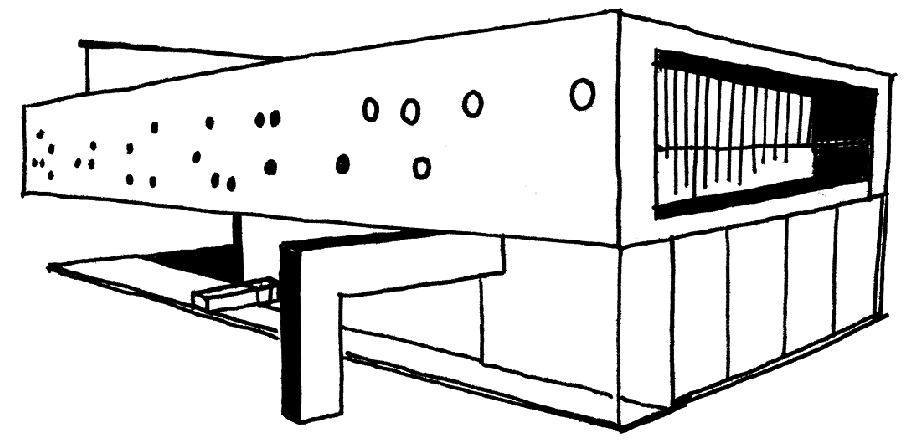

The Coolhaus Manifesto
Coolhaus (Kool-house), noun
An architecture-inspired ice cream sandwich. The Coolhaus ice cream sandwich consists of all-natural, homemade ice creams in classic and seasonal varieties, packed between two cookies of your choice.
An ice cream sandwich truck with chrome rims and a pink top (formerly a postal van). The Coolhaus truck is happily driven by architects, designers, developers, artists, bakers, actors, writers, musicians, and people from other walks of life.
A thinker. A thinker about reclaiming public and urban space for eating and gathering, when and where it is least expected. A Coolhaus thinks about how to reinvent or redesign food with an epicurean sensibility but also with an eye toward sustainability and minimal waste. A Coolhaus is passionate about food—where it comes from, how it is made, and how it is given to the eater. A Coolhaus has a curiosity for the day-to-day gastro-experience and a devotion to social merriment.
The Rocky Road to Success
A mutual friend introduced us. She told us that we have the “same kind of brain.” We instantly hit it off and, unsurprisingly, talked about food and architecture the whole time.
We started dating, and the business partnership came shortly after. Natasha was the big-picture idea person, creating flavors and not worrying too much about costs or production. Freya became the numbers and operations girl, putting her background in real estate development and finance to good use. We had the perfect complementary relationship that extended from the personal to the professional, and we had the same vision, which is what mattered most.
We began by making ice cream and cookies for friends. We didn’t let the lack of a real production plant keep us from starting our dream business. We cooked anywhere we could, even after we set fire to Freya’s mom’s kitchen while preheating the oven. (How could we know there was a pizza sitting in there? Freya’s mom has since lifted her kitchen ban.)
This unofficial but extremely serious hobby suddenly turned into a business. We hunted down recipes and developed our own tweaks. Before we knew it, we were planning our launch. We went on Craigslist and bought a dilapidated postal truck for $2,900 from three gangsta thugs who were, we suspect, using it to sell pot. They looked us up and down and asked, “What do you want this for?”
We chirpily told them, “We’re going to sell all-natural, organic ice cream sandwiches!” They must have thought that was quaint, so they offered us a discount on some cases of Pepsi, which we politely declined.
We pulled off our first gig at the Coachella Valley Music and Arts Festival in Southern California in April 2009 with a mostly under-the-influence staff. Coachella is the Woodstock-meets-Lollapalooza of our generation, with a bunch of different performers from different genres playing. Back then, it was only one weekend but has since become so popular that it has been extended to two. There were a lot of great acts playing that year—The Killers, The Cure, M.I.A, Morrissey, the Yeah Yeah Yeahs. We didn’t get to see any of them because we were working, but we could hear the rock/indie/hip-hop music wafting over from the stage, and it became our soundtrack. Today, it remains a huge part of our brand. “Coolhaus Radio,” the playlist you’ll hear at our shops and coming from our trucks, truly reflects a part of who we are.
Luck and persistence got us into Coachella. We offhandedly mentioned to a friend that we were thinking about selling our ice cream sandwiches at Coachella and that we had submitted an application but hadn’t heard back. Our friend said he happened to know the CFO of Goldenvoice, the event’s organizer, and he’d see what he could do. We obsessively followed up, and soon, someone contacted us, saying Coachella wanted to give us a shot selling in the campgrounds. (At that time there weren’t any food trucks at Coachella—we were among the first.)
It was just four weeks before the festival when we got the go-ahead. We didn’t have any production in place. We didn’t have a factory. Our truck wasn’t even up and running. But we were in, and there was no turning back.
The first thing we had to figure out was how to produce all those cookies and ice cream on our own at an event attended by a hundred thousand people. Then it dawned on us: This was not your average bake sale. We knew we couldn’t possibly do it all, so we thought . . . how do other companies do this? Thanks to a handy Google search, we found out about “co-packers.”
Co-packers are manufacturers that make your recipes, and you buy the finished goods back from them wholesale; the product belongs to you. This was completely foreign to us. We started Googling “ice cream co-packers” and “cookie co-packers” and came up with a local guy who seemed to have a substantial production company. (He does all the ice cream for Trader Joe’s.) When we told him we needed five hundred gallons of ice cream for Coachella, he started laughing. His minimum was ten thousand gallons, but he agreed to help us anyway. It was our first introduction to the world of food production.
The next thing we had to do was figure out how to get our truck to the festival. It was completely broken down, and there was no way we could drive it 120 miles. While we were looking into insurance coverage, we discovered that an AAA Premier membership was only about $200 a year—and it came with two free 200-mile tows. That would be enough to get us to the desert and back.
We had to pretend that our little truck had broken down along the way so that AAA would tow it to Coachella, but when the tow truck arrived, we discovered that commercial vehicles aren’t eligible. So we begged, saying, “We have this event! This is our dream! Please help us!”
The driver finally said, “Okay, okay. I’ll do it for you guys, but I’m letting you know that this is completely illegal and against company policy.” Freya rode in the tow truck, and Natasha followed in another car. The truck was on a flatbed and barely made it underneath the overpasses—we took deep breaths each time and hoped that it would clear.
The atmosphere at Coachella was a free-for-all when we arrived. The pizza place next to us had grabbed all the electricity and power because it got there first. Since the campground is not as big a moneymaker as the concert grounds, we were at the bottom of the totem pole. And how would we be seen amid the sprawl of tents, many of which were like mini fortresses?
But the campground had its own good vibe. It was like a little community, with a karaoke lounge, a shower area, and a store. Everyone was really young: high school and college students, people in their twenties—hippy, hipster, drifter types. The campers had paid something like $60 for the whole weekend in this hot and dusty desert. The site, truth be told, was kind of gross. There were about fifteen thousand campers and only a hundred Porta Potties and probably an equal number of showers to share—by the end, no one was using either. The camper group was definitely grungier than the crowd inside, but they were a bunch of cheerful, cool young people just having a good time.
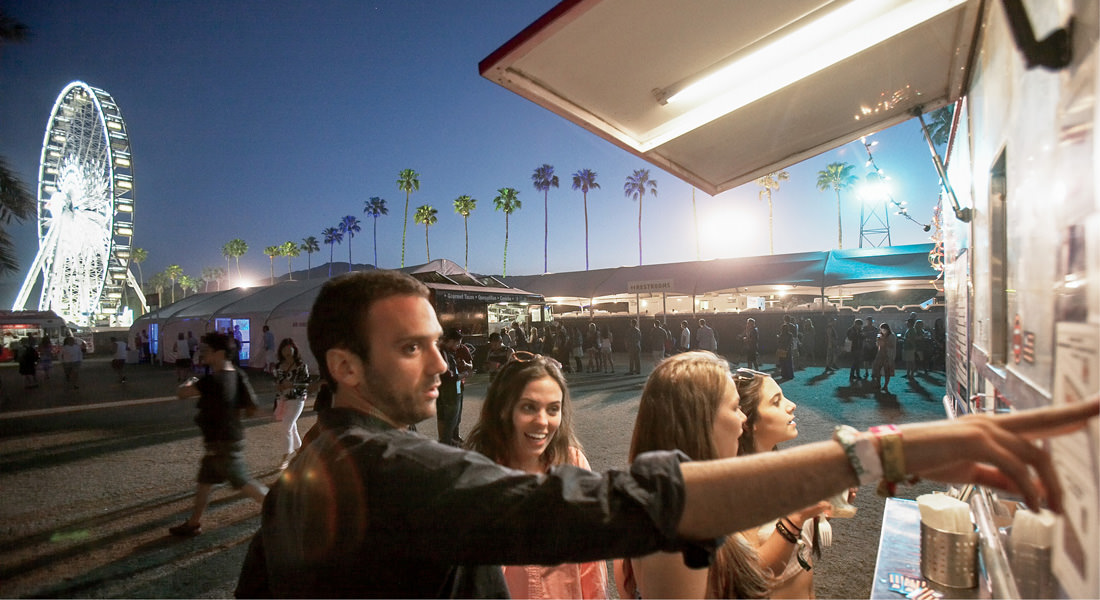
Brian Leatart
We realized some signage might help get us some attention. We didn’t have a sign that said Coolhaus—just a banner reading ice cream sandwiches. iced coffee. iced tea. We did make Coolhaus tank tops out of American Apparel, and our staff wore those with cutoff jean shorts. The first night we didn’t do very well at all. We definitely sold more drinks than ice cream sandwiches. The next day, we went to a FedEx Kinko’s and made some signage. Before long, we had lots of signs but were still short on customers.
To draw attention to our truck, our friend Jeff strung Christmas lights all around. The other vendors had normal lighting, but our area was bright, like a beacon. We set out lawn chairs and tables so people could grab a sandwich or coffee and hang out.
The lights and atmosphere definitely got us some attention. We were selling the sandwiches for about $4, with four cookies and four ice creams to choose from. People were blown away by the sweet freedom. They could decide between our small selection of cookies—Chocolate Chip, Oatmeal Raisin, Snickerdoodle, and Double Chocolate—and our basic ice creams—Dirty Mint Chip, Vanilla, Lemon, and Strawberry. They could pick one of our creations, such as the Mint-imalism, make their own kooky cookie and ice cream combo (like Oatmeal Raisin Cookies and Dirty Mint Chip Ice Cream—weird!), or even have a different top and bottom cookie.
We were contracted to sell until 2:00 a.m. But there were always last-minute orders, and we wanted to make every dollar, so we didn’t pack up and finish until 3:00 a.m. Then we’d have a “flash party” for thirty minutes, and by the time we’d go to bed, it was close to 4:00 a.m. Then we’d get up at 7:00 a.m. to serve coffee.
Managing the staff was a complete shitshow. We invited all our friends and told them that if they would work for free, they would get tickets to the festival for the entire weekend. We learned how hard it is to manage people, especially if they are your friends. Some of them had a little food service experience—others definitely did not. It was difficult to wrangle them. Sometimes they’d say, “I can’t work right now, I want to go to the show!” And some of them roamed around trying to sell ice cream sandwiches while drunk and high. It was hard for us to expect anything more, since there was no clear “We are your bosses and this is our company” understanding. Luckily, Jeff and Sarah helped hold down the fort the whole time (and they’ve been to Coachella with us every year since).
Our friends Sean and Patrick, who are very good-looking actors, were great with the tent-to-tent sales. They’d take funny pictures with girls and toss the ice cream sandwiches to people, yelling, “Catch!” and people would throw dollar bills at them. They’d return with the money, and we’d just put it in the pile. There was no inventory tracking. There was no tracking of anything, really. As the weekend went on, we became more serious and started to pay attention to the money a little more. But on the whole, we didn’t know anything about anything.
Despite our inexperience, we gained momentum, and the ice cream sandwiches started to sell pretty well. One of the most popular flavor combinations was basic chocolate chip cookies with vanilla ice cream. We called it “The Claaaassic.” (Now it’s known as the “Mies Vanilla Rohe,” after the famous German architect.) To this day, it’s the sandwich people order most.
It sunk in that we were on to something when we started to get groupies. One customer was a two-sandwiches-a-day kind of guy. He’d come by for his first at 7:00 a.m., and he’d pay $20 because he was such a big fan. Another guy had a little tattoo kit in his beret, and he kept coming up and offering to trade a tattoo for an ice cream sandwich. He would roll and unroll his kit, which looked like a weird heroin setup because of all the vials and needles. Another guy had eaten too many mushrooms and ran over in a panic saying that he needed something chewy. We scrambled to help by finding him the chewiest chocolate cookie we had.
But our biggest, and best, groupies from Coachella were Chris and Randy. One of them eventually became one of our first investors. Tall, white, lanky guys in their early twenties who sported hipster fanny packs and pants rolled up to their knees, they were Iraq war vets who had been in the air force and used their benefits to enroll in art school.
We left Coachella with some profit, some groupies, an investor, and a lot of energy and inspiration. Then the media frenzy started. While we were being towed home, Curbed LA posted about us. The post hit a nerve and went viral. Then we were on Apartment Therapy, Dwell, and Los Angeles magazine. Twitter alerts started lighting up our BlackBerries—about every five seconds! It was instant and insane, especially since at this point, the truck still didn’t move. It didn’t even have a door on it. But suddenly, our dream had become reality.
Our families and some friends were concerned—were we really going to ditch promising careers for ice cream sandwiches? We had a good feeling about it, though, and went with our instincts. From one dilapidated truck, we have now grown to fleets in Los Angeles, New York City, Dallas, and Austin; two California storefronts; an online shop; distribution in retailers across the country, including Whole Foods; and more.
Our employees and fans have drunk the Coolhaus Kool-Aid, and together, finally, we found ourselves responsible for a movement of cool-kid food. Sweet, fun, delicious—but in no way junk.
—Natasha and Freya, 2014
Before You Begin: Tools
Just as an architect needs a drafting board and a builder needs hammers and nails, cooks need their tools, too. Here’s what you need to engineer the best Coolhaus sandwiches.
Tools
For ice cream:
An ice cream maker. There are two general kinds: gel canister and compressor. (We don’t recommend using the old-fashioned bucket ice cream makers—they are labor-intensive and messy.)
Gel canisters are otherwise known as “freezer bowl” models; basically you freeze the removable bowl before churning the base into a frozen state. They are gently priced, usually under $100. We recommend the Cuisinart ICE-21 gel canister ice cream maker for its ease of use, reasonable price, and consistent results. Ice cream made in a gel canister needs to be frozen for about 2 hours before serving, for a firm texture.
Tips for using gel canister ice cream makers:
Clear out your freezer. The bowls can take up quite a bit of space.
Plan ahead. The bowls usually need to be frozen overnight (check the manufacturer’s instructions). The colder the bowl, the faster and better the ice cream freezes.
Buy an extra freezer bowl. If you want to make more than one flavor at a time, one bowl will always be completely frozen and ready to use.
Do not take the bowl out of the freezer until ready for use. They can defrost very quickly.
Compressors have a built-in freezing mechanism. They are considered “professional quality” and are more expensive, from $200 to $1,000. They are convenient since you don’t have to pre-freeze the bowl before use (freeing up your freezer space), and they produce an immediate firm consistency. We recommend the Simac and Cuisinart ICE-100 compressors for their ease of use and great results.
Tips for using compressor ice cream makers:
Tips for using all ice cream makers:
Other useful tools for ice cream making:
Whisk
Cooking thermometer
4-quart saucepan
4-quart pitcher (with lid) for storing and pouring the base
4-quart airtight containers for storing the ice cream
Kitchen scale
Liquid and dry measuring spoons and cups
Microplane zester
Immersion blender
Blender or food processor
Rubber spatula
Large wooden mixing spoons
Ice cream scoop
Fine-mesh sieve
Sifter
For cookies:
Hand mixer or stand mixer
Two baking sheets (half-sheet pans work best)
Mixing bowls of various sizes
Mixing spoon
Rubber spatula
Cooling rack
Kitchen scale
For toppings:
Sources
Some of the ingredients for our more exotic flavors may not be easy to find in your corner supermarket. Here are some recommended sites for general ingredients. (We also recommend sites for specialty ingredients within the recipes.)
www.penzeys.com
www.culinarydistrict.com
www.kalustyans.com
Tips & Troubleshooting
Ice cream and cookies are pretty hard to ruin, and once you make one or two batches, the process becomes second nature. That said, we found ways to screw things up when we were first starting out. But we look at it this way: We made mistakes so that you don’t have to! Here are some paths to pursue and pitfalls to avoid to achieve perfection.
Don’t overcook the base. Beware of curdling the base when cooking it. This happens when the base gets too hot too quickly. If it starts to have the consistency of scrambled eggs, it’s overcooked. Scrambled egg ice cream is not in our preferred repertoire of flavors (unless bacon is involved).
Don’t overchurn/overfreeze the ice cream. When the ice cream comes out of the maker, it should have the consistency of soft serve. If it is like a stick of butter, it is overchurned and will be rock-hard after freezing. The thermometer reading should be 20 degrees for a properly frozen ice cream. To fix overfrozen ice cream: Melt down the ice cream with 30-second zaps in the microwave until it is liquid; strain out the mix-ins; mix with an immersion blender or hand mixer; add the mix-ins; then refreeze. Do not do this more than once, as you will be asking for a bacteria fest in your ice cream. If your ice cream is overfrozen again, throw it away and start over.
Add alcohol at the end of the process. Alcohol has a high freezing point, but adding spirits at the end doesn’t impede the freezing process.
Use sorbet strategies. If the sorbet comes out too slushy, add more water a tablespoon at a time as you continue to churn it in the ice cream maker until it reaches the desired consistency. If the sorbet seems too hard, add more sugar. For more sorbet tips, see Tips for Sorbet Making.
Know your oven’s true temperature. Ovens can vary wildly in the reliability of their thermostats. Use an oven thermometer to double-check yours. And always check cookies at their minimum baking time for doneness to avoid overbaking. For more cookie tips, see the Cookies chapter.
For Best Results
Make it fresh and keep it cold. Get the base into the fridge to chill as quickly as possible to prevent spoilage, and do not store it for longer than 5 days.
Flavor comes first. Use the freshest, best ingredients you can find for best results.
Plan ahead. Making the ice creams in this book is a 2-day process, because you’ll need to refrigerate the base at least overnight (unless you use our eggless or sorbet base). And if you are using a gel canister machine, always make sure your bowls have been in the freezer for 12 to 24 hours.
Make space. Don’t forget to make room for your base in the fridge and room for the final product in the freezer.
Bump up the flavor. Cold mutes the flavor of ingredients, so use your taste buds and don’t be afraid to err on the side of generosity when adding spices, herbs, mix-ins, and other flavorings.
Mix-ins come last. As a rule of thumb, save the mix-ins until the end of the freezing process for even distribution and to prevent them from sinking to the bottom.
Make it ahead. Freeze ice cream for at least 2 hours before serving, for the best consistency. Our ice creams have a soft-serve consistency when the machine finishes the process. Further freezing in an airtight storage container is necessary for firmness.
Never store ice cream, gelato, or sorbet in the canister. Do not store ice cream in the canister, since it may stick to the sides of the container and damage the bowl.
Watch the shelf life. Since our ice creams, gelatos, and sorbets are all-natural, with no preservatives, they should not be kept for longer than 2 weeks. Refrigerated cookie dough should be used within 2 weeks. Frozen cookie dough can be kept for up to 3 months.
Swirling Tips for Ice Cream
An artful swirl in an ice cream not only is functional, providing an even distribution of the swirled ingredient, but makes the ice cream look pretty. Keep these tips in mind for recipes that call for a swirl:
Put a little bit of the swirl ingredient in a large, cold bowl, add all the ice cream as quickly as possible, then drizzle the remaining swirl ingredient on top. Draw a rubber spatula through the ice cream 3 to 4 times.
Use an economy of motion when swirling: A few broad circular gestures with a rubber spatula usually does the trick.
A little bit of a swirl ingredient goes a long way; be careful not to overdo it or the inclusions will permeate the base too much.
When you’re finished swirling, place the bowl in the freezer and allow the ice cream to firm up for 20 to 30 minutes before transferring it to an airtight storage container.
Building the Perfect Sandwich
Make the sandwich. Place 1 cookie top side down on a work surface. Scoop 1 to 2 scoops (we use a 4-ounce scoop) of hard ice cream, gelato, or sorbet on top. Place another cookie top side up on top of the ice cream and press down lightly to even the filling and stick the sandwich together.
Freeze the entire sandwich. Freezing the sandwich as a whole unit makes it easier to eat, with less melty ice cream spilling out the sides. Homemade Coolhaus ice cream sandwiches are good to go after a minimum of 1½ hours in the freezer and will keep for up to 2 weeks.
Most important: Have fun! There shouldn’t be anything dull about making ice cream and cookies. Invite friends, have a party, and feel free to experiment! Believe us, there’s nothing more satisfying than building your own Coolhaus dream sandwich.
Ice Creams, Gelatos & Sorbets: What’s the Difference?
Ice cream is a frozen dairy dessert that combines water, butterfat, sugar, and flavoring. Ours are custard-based and made with milk, cream, eggs, sugar, and inclusions. These elements are churned together, which whips air into the base. We strive for a lusciously creamy texture with a strong layering of flavor.
Gelato is the Italian word for ice cream, though there are some distinct differences. Gelato is usually denser and stickier in texture, with less air and less butterfat. Our gelato base includes milk, sugar, and eggs, but no cream.
Sorbet contains no dairy and has an icy, more granular texture than ice cream and gelato. It’s made from frozen water, sugar, and flavorings.
Got it? Good. Our recipes are very easy for home chefs of all calibers—beginner to pro. With each one, we include a “skyscraper” rating system.
|

|
=
|
EASIEST
|
|
|
=
|
EASY BUT TIME-CONSUMING
|




